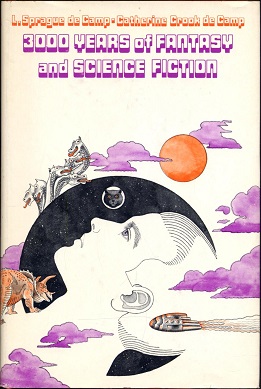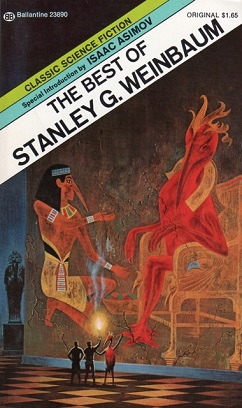
Mars, the fourth planet from the Sun, has appeared as a setting in works of fiction since at least the mid-1600s. Trends in the planet's portrayal have largely been influenced by advances in planetary science. It became the most popular celestial object in fiction in the late 1800s, when it became clear that there was no life on the Moon. The predominant genre depicting Mars at the time was utopian fiction. Around the same time, the mistaken belief that there are canals on Mars emerged and made its way into fiction, popularized by Percival Lowell's speculations of an ancient civilization having constructed them. The War of the Worlds, H. G. Wells's novel about an alien invasion of Earth by sinister Martians, was published in 1897 and went on to have a major influence on the science fiction genre.

Stanley Grauman Weinbaum was an American science fiction writer. His first story, "A Martian Odyssey", was published to great acclaim in July 1934; the alien Tweel was arguably the first character to satisfy John W. Campbell's challenge: "Write me a creature who thinks as well as a man, or better than a man, but not like a man." Weinbaum wrote more short stories and a few novels, but died from lung cancer less than a year and a half later.
"Loophole" is a science fiction short story by British writer Arthur C. Clarke, first published in 1946 in the magazine Astounding Science Fiction. It was subsequently published as part of a short story collection in A Treasury of Science Fiction (Groff Conklin, 1948 and Expedition to Earth in 1953.

"A Martian Odyssey" is a science fiction short story by American writer Stanley G. Weinbaum originally published in the July 1934 issue of Wonder Stories. It was Weinbaum's second published story, and remains his best known. It was followed four months later by a sequel, "Valley of Dreams". These are the only stories by Weinbaum set on Mars.
"Parasite Planet" is a science fiction short story by American writer Stanley G. Weinbaum originally published in the February 1935 issue of Astounding Stories. It was Weinbaum's fourth published story, and the first to be set on Venus. He quickly followed it up with a sequel called "The Lotus Eaters".
"The Planet of Doubt" is a science fiction short story by American writer Stanley G. Weinbaum that was first published in the October 1935 issue of Astounding Stories. It is Weinbaum's third story featuring Hamilton Hammond and Patricia Burlingame, a sequel to "Parasite Planet" and "The Lotus Eaters".
"The Mad Moon" is a science fiction short story by American writer Stanley G. Weinbaum, first published in the December 1935 issue of Astounding Stories. As did his earlier stories "A Martian Odyssey" and "Parasite Planet", "The Mad Moon" emphasizes Weinbaum's alien ecologies. "The Mad Moon" was the only Weinbaum story set on Io.
"Redemption Cairn" is a science fiction short story by American writer Stanley G. Weinbaum that first appeared in the March 1936 issue of Astounding Stories. "Redemption Cairn" is the only Weinbaum story set on Europa.
Tweel is a fictional extraterrestrial from the planet Mars, featured in two short stories by Stanley G. Weinbaum. The alien was featured in A Martian Odyssey, first published in 1934, and Valley of Dreams four months later. Weinbaum died of lung cancer soon after, and a third installment in the series never saw fruition. Tweel remains one of the most recognised aliens in early science fiction, and is said to be an inspiration for aliens in the works of Isaac Asimov and Arthur C. Clarke.

"The Red Peri" is a science fiction novella by American writer Stanley G. Weinbaum, which first appeared in the November 1935 issue of Astounding Stories. Sam Moskowitz has noted that Weinbaum planned to write a series of sequels to "The Red Peri" but died before he could do so. "The Red Peri" is the only Weinbaum story set on Pluto. The novel also inspired Arthur C. Clarke, who stated that David Bowman's helmetless spacewalk in 2001: A Space Odyssey was inspired by Frank Keene's escape from the pirate base in "The Red Peri".
"Tidal Moon" is a science fiction short story by American writer Stanley G. Weinbaum and Helen Weinbaum that first appeared in the December 1938 issue of Thrilling Wonder Stories and was reprinted in the collection Interplanetary Odysseys (2006). Sam Moskowitz stated that Stanley G. Weinbaum completed only a page and a half of the story before his death and that his sister Helen Weinbaum completed the story on her own. "Tidal Moon" is the only story by Weinbaum to take place on Ganymede.
Tweel is an airless tire design concept developed by the French tire company Michelin.

3000 Years of Fantasy and Science Fiction is an anthology of fantasy and science fiction short stories, edited by American writers L. Sprague de Camp and Catherine Crook de Camp. It was first published in both hardcover and paperback by Lothrop Lee & Shepard in 1972. It was the first such anthology assembled by the de Camps, preceding their later Tales Beyond Time (1973).

Flight to Mars is a 1951 American Cinecolor science fiction film drama, produced by Walter Mirisch for Monogram Pictures, directed by Lesley Selander, that stars Marguerite Chapman, Cameron Mitchell, and Arthur Franz.
The Planetary series of stories by Stanley G. Weinbaum is a series of short stories, published in Wonder Stories and Astounding Stories in the 1930s, which are set upon various planets and moons of the Solar System.
"The Adaptive Ultimate" is a science fiction short story by American writer Stanley G. Weinbaum, about an experimental medical treatment gone awry. It was first published in the November 1935 issue of Astounding magazine under the pen name "John Jessel". It was collected in various editions of A Martian Odyssey, as well as the 1979 The Best Of Stanley G. Weinbaum.

A Martian Odyssey and Others is a collection of science fiction short stories by author Stanley G. Weinbaum. It was first published in 1949 by Fantasy Press in an edition of 3,158 copies. The stories originally appeared in the magazines Wonder Stories, Astounding and Thrilling Wonder Stories.

Ancient astronauts have been addressed frequently in science fiction and horror fiction. Occurrences in the genres include:

The Best of Stanley G. Weinbaum is a collection of science fiction stories by Stanley G. Weinbaum, published in 1974 as an original paperback by Ballantine Books as a volume in its Classic Library of Science Fiction. The volume included an introduction by Isaac Asimov and an afterword by Robert Bloch. Ballantine reissued the collection twice in the later 1970s; Garland Publishing published a library hardcover edition in 1983, and Sphere Books released a UK market edition in 1977, under the title A Martian Odyssey and Other Stories. The original edition placed third in the 1975 Locus Poll for best genre collection.

The Science Fiction Bestiary is an anthology of science fiction novelettes and short stories edited by Robert Silverberg. It was first published in hardcover by Thomas Nelson in 1971; it was reprinted in March 1973. The first paperback edition was published by Dell Laurel in February 1974. It has also been translated into German.









